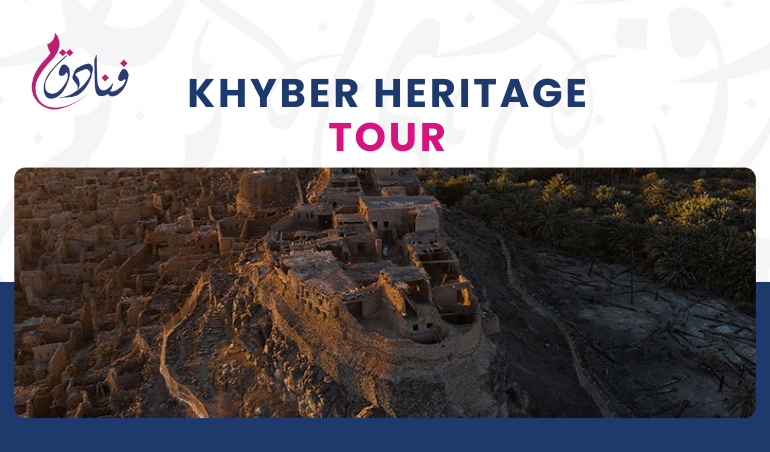Khyber Heritage Tour | One Day Trip
By Funadiq Team
Funadiq is dedicated to helping Umrah pilgrims and leisure travelers organize their journeys to Saudi Arabia and explore Islamic historical sites. When you travel to Saudi Arabia for pilgrimage purposes, you'll have the opportunity to visit historic places where ancient battles were fought between believers and non-believers. Saudi Arabia is home to a number of Islamic sites of significant value in Islamic history. One such site is the Khaybar fort, a location that is mentioned in the Holy Quran. With its unique volcanic desert landscape and rich historical significance, Khaybar offers a captivating blend of culture, heritage, and nature. It's a chance to unlock the secrets of prehistoric Saudi Arabia and immerse yourself in the history and beauty of the region.
Location of the Great Ancient Oasis
The ancient and picturesque oasis of Khaybar is situated approximately 170 kilometers north of Madinah, a convenient two-hour drive away. Nestled in a series of depressions that collect rainwater, this oasis has been home to lush palm trees for countless millennia. Covering vast acres, Khaybar Oasis is encircled by volcanic fields known as "harra(t)," with the largest one being named Harrat Khaybar after the oasis itself.
Khaybar is situated approximately 200 km southeast of AlUla, on the main road to and from Madinah and Jeddah. The transfer from AlUla, as part of the Khaybar Day Trip package, takes 2 hours and 15 minutes in a luxurious coach.
Abundance of Life
The beautiful landscape is surrounded by ancient volcanic terrain, imparting an otherworldly atmosphere to the area. Khaybar Oasis is a breathtaking natural wonder that supports a diverse array of plant life and wildlife. This enchanting oasis owes its existence to natural freshwater springs and valleys, creating an inviting refuge for both humans and creatures alike.
In a breathtaking landscape, a distinct setting creates a haven for diverse forms of life through its continuous waterways. These natural channels, flowing gently through the lower part of the oasis, nurture vibrant and lush plant life. A network of irrigation canals extend from wells, quenching the thirst of the majestic palm trees and providing a glimpse into what an ancient Arabian oasis might have looked like over two millennia ago.
History of Khayber
The Khaybar Fort has immense value in Islamic history as it is the place where Jews barricaded themselves during the famous battle of Khaybar. The exact date of construction of this fort is still not confirmed; archeological evidence shows that the fort was built in the pre-Islamic era. The fort is believed to have served as a strong refuge for Jewish tribes who inhabited the Khaybar oasis. These Jewish tribes were skilled in warfare and agriculture. The fort was built for defensive purposes due to its ideal strategic location.
Khyabar Fort rose to prominence during the historic Battle of Khaybar in 629 CE. The mounting tensions between the Muslim community in Madinah and the Jewish population of Khaybar had been escalating over time. Suspicion arose that the Jews had formed alliances with the Quraysh tribe of Makkah, who were known as vehement opponents of Islam. These growing tensions culminated in the Battle of Khaybar, where the Muslims, under the leadership of Prophet Muhammad PBUH, faced the forces of the Jewish community.
Prophet Muhammad, along with other Muslims, conducted a siege of the Khybar Fort, strategically capturing various areas and emerging victorious after several days. As a result, some Jewish tribes chose to remain in Khaybar under a peace treaty, while others migrated elsewhere."Prophet Muhammad PBUH, with other Muslims, sieged Khybar Fort for several days, strategically capturing various areas of the fort. After several days of siege, Muslims emerged victorious, securing significant dominance over their adversaries. Following the battle, some Jewish tribes chose to remain in Khaybar under a peace treaty, while others migrated elsewhere.
Archeological Structure of Khaybar
Khaybar Fort was not just a single structure but a complex network of forts and castles spread across the Khaybar oasis. This fortified system provided a formidable defense, with high walls made from black volcanic rock and mudbricks and strategically placed watchtowers offering a commanding view of the surrounding area for early detection of potential threats. The design of the fortifications made it challenging for invading forces to conquer the region, reflecting a well-planned and robust defensive strategy.
Things to Know Before Visiting Khayber
The site is not free to enter, and visitors are required to purchase tickets. Whether you are accompanied by a tour guide or exploring independently, it's advisable to arrive 15 minutes prior to your scheduled entry time. For your comfort, it is recommended to wear suitable outdoor attire and sturdy footwear such as shoes or boots. Additionally, it's advisable to bring a hat, sunglasses, and sunscreen, as there are areas with prolonged exposure to direct sunlight.
The location is conveniently situated along the road between Tayma and Madinah, with easy access from a side road that leads to a square in the old town where parking is available for vehicles.
Final Thoughts
With your sights set on Umrah, consider venturing beyond the sacred sites of Makkah and Madinah to explore the captivating oasis of Khaybar. Funadiq is here to guide you on this historical and cultural adventure.
Khaybar offers a unique blend of experiences. Immerse yourself in the rich tapestry of Islamic history at the famed Khaybar Fort, a witness to the Battle of Khaybar. Delve into the region's archaeological wonders, with the fort's unique volcanic landscape and defensive structures whispering tales of a bygone era. But Khaybar is more than just history. This lush oasis, cradled by ancient volcanic terrain, boasts a vibrant ecosystem overflowing with life.




0 Comments